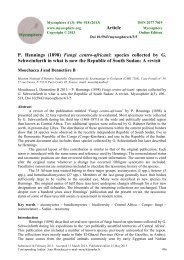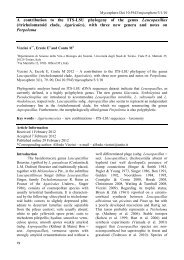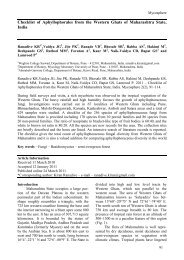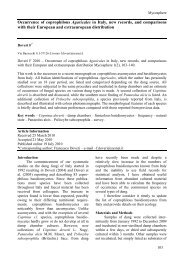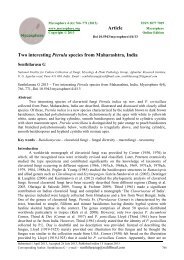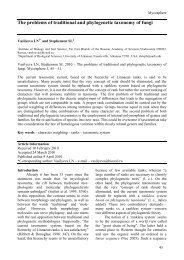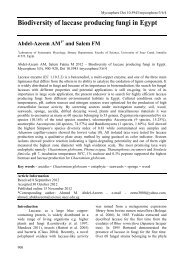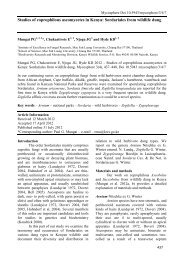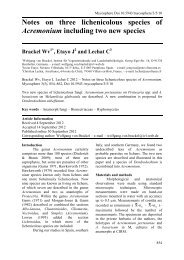Towards incorporating anamorphic fungi in a natural ... - Mycosphere
Towards incorporating anamorphic fungi in a natural ... - Mycosphere
Towards incorporating anamorphic fungi in a natural ... - Mycosphere
You also want an ePaper? Increase the reach of your titles
YUMPU automatically turns print PDFs into web optimized ePapers that Google loves.
Huhndorf et al. (2009) described this<br />
teleomorphic genus <strong>in</strong> Amplistromataceae with<br />
Acrodontium-like anamorphs.<br />
Ampullicephala R.F. Castañeda, M<strong>in</strong>ter & M.<br />
Stadler (8)<br />
Castañeda Ruiz et al. (2009a) described<br />
this new genus to accommodate Pleurotheciopsis<br />
setiformis R.F. Castañeda. No teleomorph<br />
relationship is known.<br />
Anaselenosporella Heredia, R.F. Castañeda &<br />
R.M. Arias (9)<br />
Castañeda Ruiz et al. (2010a) <strong>in</strong>troduced<br />
this new monotypic hyphomycete genus from<br />
Mexico. No teleomorph relationship is known.<br />
Anguillospora Ingold (10)<br />
Shearer et al. (2009) showed the generic<br />
type to be <strong>anamorphic</strong> Amniculicolaceae based<br />
on phylogenetic analyses of SSU and/or LSU<br />
genes.<br />
Antennariella Bat. & Cif. (11)<br />
Crous et al. (2009a) showed one species<br />
<strong>in</strong> this genus to be a member of Capnodiaceae<br />
<strong>in</strong> a phylogeny derived from partial LSU genes<br />
<strong>in</strong>dicat<strong>in</strong>g that the <strong>anamorphic</strong> genus may be<br />
polyphyletic as it has already been l<strong>in</strong>ked with<br />
Antennulariella <strong>in</strong> Antennulariellaceae. Cheewangkoon<br />
et al. (2009) <strong>in</strong>troduced a new<br />
species <strong>in</strong> the genus <strong>in</strong> Capnodiales based on<br />
LSU gene analysis.<br />
Anthonectria Döbbeler (12)<br />
Döbbeler (2010) <strong>in</strong>troduced a new<br />
teleomorphic genus from the develop<strong>in</strong>g sporophytes<br />
of Drepanolejeunea sp. which had a<br />
pulv<strong>in</strong>ate <strong>anamorphic</strong> state with ramify<strong>in</strong>g<br />
cyl<strong>in</strong>drical conidiogenous cells and small<br />
globose colourless conidia.<br />
Aplosporella Speg. (13)<br />
Taylor et al. (2009) described a new<br />
species from Australia. The teleomorph is<br />
unknown, however some species clustered<br />
basal to Botryosphaeriaceae. This genus has<br />
over 300 species and appears to be heterogenous;<br />
therefore not all species are likely to<br />
belong <strong>in</strong> Botryosphaeriaceae.<br />
60<br />
Aposphaeria Sacc. (14)<br />
Aveskamp et al. (2010) confirmed one<br />
species belonged <strong>in</strong> Melanommataceae follow<strong>in</strong>g<br />
multigene analysis.<br />
Aposphaeria-like (15)<br />
Boehm et al. (2009a) described Gloniopsis<br />
and the new teleomorph genus Hysterobrevium<br />
as hav<strong>in</strong>g Aposphaeria-like anamorphs.<br />
Aquaticheirospora Kodsueb & W.H. Ho (16)<br />
Shearer et al. (2009) showed the generic<br />
type to be <strong>anamorphic</strong> Massar<strong>in</strong>aceae based on<br />
phylogenetic analyses of SSU and/or LSU<br />
genes.<br />
Arthrobotrys Corda (17)<br />
Li et al. (2009) described a new member<br />
of this genus as <strong>anamorphic</strong> Orbilia.<br />
Aschersonia Mont. (18)<br />
Confirmed as <strong>anamorphic</strong> Moelleriella<br />
(Tadych et al. 2009) and <strong>anamorphic</strong> Hypocrella<br />
(Mongkolsamrit et al. 2009).<br />
Ascochyta Lib. (19)<br />
Ascochyta pisi Lib. was l<strong>in</strong>ked to the<br />
teleomorph Didymella pisi Chilvers, J.D.<br />
Rogers & Peever (Chilvers et al. 2009).<br />
Aveskamp et al. (2010) noted the polyphyletic<br />
nature of this genus.<br />
Aspergillus P. Micheli ex L<strong>in</strong>k (20)<br />
Two species of teleomorphic Neosartorya<br />
with anamorphs <strong>in</strong> Aspergillus section<br />
Fumigati were described by Yaguchi et al.<br />
(2010).<br />
Aureobasidium Viala & G. Boyer (21)<br />
Suetrong et al. (2009) showed one<br />
species to be <strong>anamorphic</strong> Dothideaceae based<br />
on phylogenetic analyses of four genes.<br />
Asterosporium Kunze (22)<br />
Tanaka et al. (2010) transferred one<br />
species <strong>in</strong> this genus to Prosthemium and found<br />
that another species lay <strong>in</strong> Diaporthales. The<br />
type species was not used <strong>in</strong> this study.



